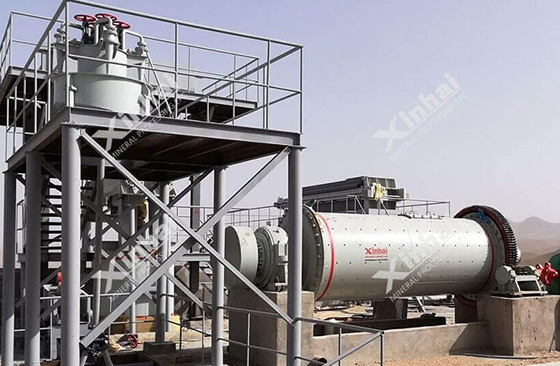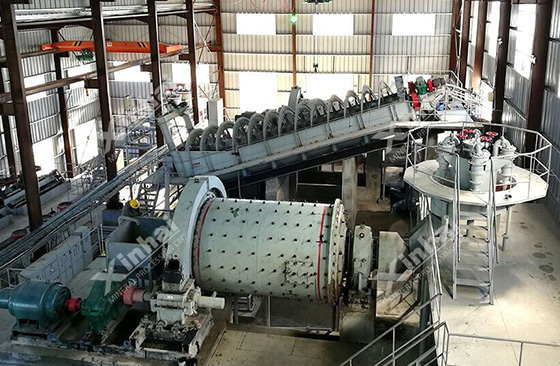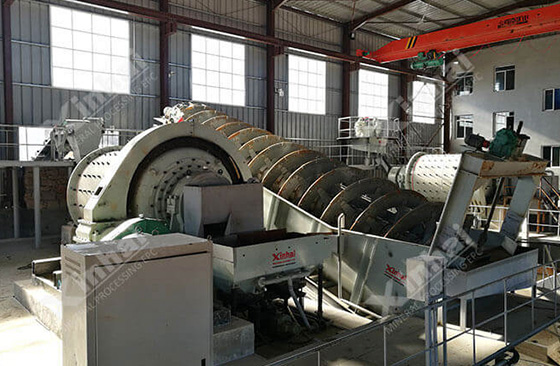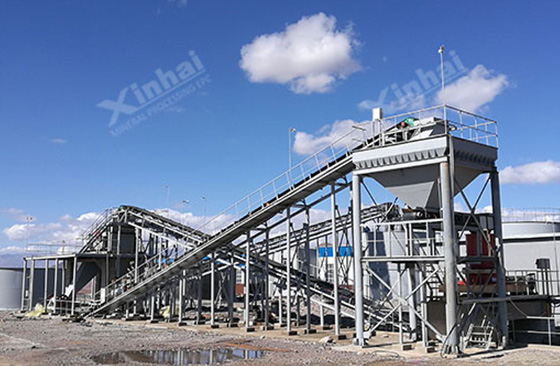Minerals rich in silver are called silver minerals. Pure silver is silvery white, so it is also called white silver. Among all metals, silver has a series of merits including highest conductivity and thermal conductivity, good ductility and plasticity, ease of polishing and molding, and forming alloy or psudoalloy with many metals. With the mining of silver ore, the grade of silver-bearing ore is gradually reduced. Therefore, it is very important to realize the high-efficiency extraction process of silver-bearing ore. It is of great significance to realize the comprehensive recycling of resources and promote the cyclic development of industrial economy.
The required silver extraction process varies from the different mineral nature. The mineral extraction method usually used for independent silver ore centering on silver production is flotation extraction process. While paragenetic and associated silver mines often use single flotation method, flotation-gravity separation method, and flotation-cyanidation method, with flotation being the most important process.

Use the table of contents below to navigate through the guide:
01Silver Types
Silver-bearing ore is mainly divided into gold-silver ore and lead-zinc-copper associated silver ore. Its silver production accounts for more than 99% of the total silver output.
1.Gold-silver Ore
In addition to gold, each ton of gold-silver ore contains tens of grams to several hundred grams of silver.
In the primary gold-silver mine, silver is often present in the form of spiral-like sulfur-silver ore, deep red-silver ore, brittle silver ore, native silver, sulphur-bismuth-copper-silver ore; In the oxidized ore, halogenide (horn silver ore) and sulphate (argentojarosite) containing silver and native silver often closely associated with clay minerals, iron oxides and manganese oxide.
Native silver particles are often covered by some metal oxide and hydroxide thin films. Gold minerals exist in the form of native gold and silver-gold ore, and the gold particles are very fine.
2.Lead-zinc-copper Associated Silver Ore
Silver mainly exists as independent minerals.
Various compounds of silver and sulfur, copper, lead, tin, antimony, bismuth, selenium, arsenic and other elements appear in various deposits. Commonly, there are argentite-acanthite, jalpaite, pyrargyrite, stephanite, proustite, polybasite, andorite, diaphorite, hessite and naumannite.
A small amount of silver occurs in ores as the single substance mineral, such as native silver.
There is also a small amount of silver that does not have an independent form in the ore, but forms isomorphism in the crystal lattice of other minerals, such as electrum and freibergite.
Various silver minerals are closely symbiotic with the sulfide minerals of lead, zinc and copper, and are mostly distributed as fine grain dissemination. The particle size of silver minerals is almost below 0.04 mm, the majority of silver minerals have a particle size of 0.04-0.02 mm, and the finest is only 0.001 mm. Fine silver minerals are distributed in galena, sphalerite, and copper sulfide minerals in the form of continuum, inclusions, and microscopic bodies.
During the flotation process, those sulfide minerals that are closely related to silver minerals will become their carriers, enriching silver into various concentrate products. Therefore, the occurrence and embedded properties of silver minerals have a major impact on the comprehensive extraction of silver.

02Extraction of Gold-silver Ore
Because gold-silver ores contain many kinds of silver minerals that often appear in various states, two or more mineral extraction methods are used to form a combined process for gold-silver ores extraction. In general, the extraction methods of gold-silver ore mainly include flotation and cyanidation processes. The use of flotation or cyanidation primarily depends on the composition of silver mineral:
When silver minerals are mainly pyroxene silver and natural silver, both flotation and cyanidation extraction processes can be used:
When the silver ore contains a lot of minerals hard for cyanidation such as deep-red silver minerals, light-red silver minerals, selenium silver minerals, only flotation extraction method can be used.
It is worth noting that flotation method and cyanidation method are different in terms of silver’s recovery rate. The recovery rate of cyanidation method is generally higher than that of flotation method.

The common gold-silver ore extraction process has the following types:
1. Flotation + Flotation concentrate cyanidation
The sulfide ore containing gold, silver and quartz veins is subjected to flotation process to obtain a small amount of concentrate, which is then sent to cyanidation process. Compared with all-sliming cyanidation process, the flotation concentrate cyanidation process has the advantages of not requiring fine grinding minerals, reducing power consumption, occupying small plant area, and saving capital investment.
2. Flotation + Concentrate calcination + Calcination cyanidation
This process is commonly used to process insoluble gold-arsenic ore, gold-bismuth ore and gold-pyrite ore with extremely high sulfide content. The purpose of calcination is to remove elements such as arsenic and antimony which are harmful to cyanidation process.
3. Flotation + Flotation concentrate pyrometallurgical process
Most polymetallic sulfide ores containing gold and silver are processed in this extraction process. In flotation process, gold and silver enter copper, lead and gold minerals which are closely symbiotic to them, and are sent to smelting plant to recover gold and silver.
4. Flotation + Flotation tailings or middling cyanidation + Flotation concentrate in situ calcination cyanidation
This scheme is used to process quartz-sulfide ore containing antimony telluride, pyrrhotite, chalcopyrite and other sulfide minerals. Sulfide ore will be obtained as concentrate after flotation and the gold-silver concentrate will be conducted calcination and then cyanidation process. Due to the high content of gold and silver in flotation middlings and tailings, it is necessary to recycle by cyanidation.
5. Raw ore cyanidation + Cyanidation tailings flotation
When the gold and silver symbiotic with the sulfide in the ore cannot be completely recovered by the cyanidation method, it’s recommendable to improve the gold and silver recovery rate of the cyanidation slags after flotation process.

Silver ore characteristics and extraction methods:
| Silver Ore Characteristics | Silver Extraction Processes |
| Coarse particles (> 0.1 ~ 0.2mm) of natural silver and natural alloys | Gravity separation |
| Cyanidation |
| Native silver and native alloys particles in free and intergrowth state (< 0.1 to 0.2 mm) | Cyanidation |
| Flotation and cyanidation or melting of the concentrate in the next step① |
| Cerargyrite particles in free or intergrowth state | Cyanidation① |
| Simple sulfide of silver in free and intergrowth state | Flotation and cyanidation or melting of the concentrate in the next step |
| Cyanidation① |
| Silver telluride, selenide and complex sulfides and silver iron vanadium particles in free and intergrowth state | Oxidizing roasting or chloridizing roasting and cyanidation of calcine in the next step |
| Flotation and smelting or roasting of the concentrate in the next step , and cyanidation of calcine |
| Silver in galena, chalcopyrite, chalcocite and other non-ferrous sulfide minerals | Flotation and smelting of the concentrate in the next step① |
| Silver in iron sulfide | Flotation, oxidizing roasting or chloridizing roasting of the concentrate in the next step and cyanidation of calcine① |
①The coarse particles of minerals can be extracted by gravity separation.


 marketing@ytxinhai.com
marketing@ytxinhai.com  0086 13810327080
0086 13810327080 






































































































 CHAT
CHAT MESSAGE
MESSAGE






